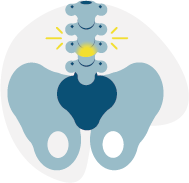There is an extensive variety of treatments available for discogenic pain, to address the different stages. The first stage treatment option is conservative treatment, which consists of exercises and physical therapy to strengthen the trunk and abdominal muscles, and specific changes in lifestyle, such as losing weight, giving up smoking, among others.
Pharmacological treatment also has an important role in pain management. There are various analgesic medications (anti-inflammatories, corticosteroids, opiate derivatives ...) that are useful for reducing discogenic pain, including minimally invasive steroid injections. It is important that analgesic guidelines and patient monitoring be carried out by specialists in this type of pathology.
Finally, there are several surgical alternatives for those individuals who, despite conservative treatment, continue to suffer discogenic pain. The classic technique consists of spinal fusion or arthrodesis of the level affected by the discopathy.
This surgery can be carried out with different materials, techniques or approaches, depending on each specific case. An alternative to spinal fusion is arthroplasty surgery. This procedure consists of replacing the pathological disc with a prosthesis that mimics the structure and function of a healthy natural disc.

